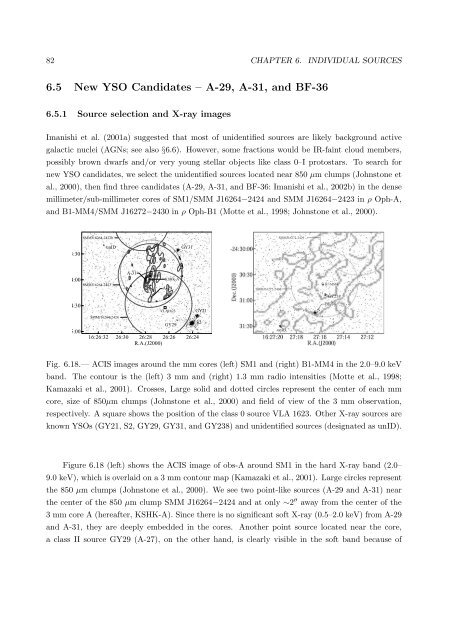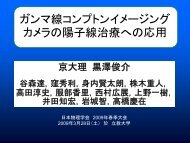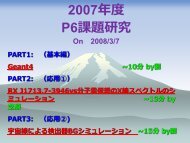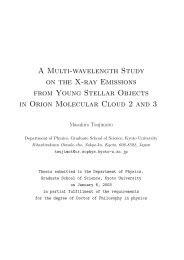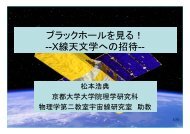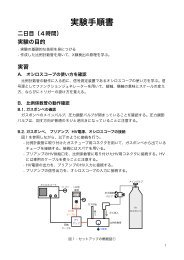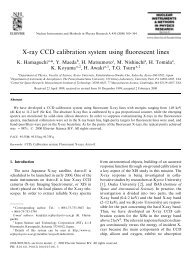X-ray Study of Low-mass Young Stellar Objects in the ρ Ophiuchi ...
X-ray Study of Low-mass Young Stellar Objects in the ρ Ophiuchi ...
X-ray Study of Low-mass Young Stellar Objects in the ρ Ophiuchi ...
You also want an ePaper? Increase the reach of your titles
YUMPU automatically turns print PDFs into web optimized ePapers that Google loves.
82 CHAPTER 6. INDIVIDUAL SOURCES6.5 New YSO Candidates – A-29, A-31, and BF-366.5.1 Source selection and X-<strong>ray</strong> imagesImanishi et al. (2001a) suggested that most <strong>of</strong> unidentified sources are likely background activegalactic nuclei (AGNs; see also §6.6). However, some fractions would be IR-fa<strong>in</strong>t cloud members,possibly brown dwarfs and/or very young stellar objects like class 0–I protostars. To search fornew YSO candidates, we select <strong>the</strong> unidentified sources located near 850 µm clumps (Johnstone etal., 2000), <strong>the</strong>n f<strong>in</strong>d three candidates (A-29, A-31, and BF-36: Imanishi et al., 2002b) <strong>in</strong> <strong>the</strong> densemillimeter/sub-millimeter cores <strong>of</strong> SM1/SMM J16264−2424 and SMM J16264−2423 <strong>in</strong> <strong>ρ</strong> Oph-A,and B1-MM4/SMM J16272−2430 <strong>in</strong> <strong>ρ</strong> Oph-B1 (Motte et al., 1998; Johnstone et al., 2000).SMMJ16264-2422b-24:23:30unIDGY31Dec.(J2000)24:0024:3025:00SMMJ16264-2423SMMJ16264-2424A-31SM1KSHK-AA-29VLA1623GY2916:26:32 26:30 26:28 26:26 26:24R.A.(J2000)GY21S2Fig. 6.18.— ACIS images around <strong>the</strong> mm cores (left) SM1 and (right) B1-MM4 <strong>in</strong> <strong>the</strong> 2.0–9.0 keVband. The contour is <strong>the</strong> (left) 3 mm and (right) 1.3 mm radio <strong>in</strong>tensities (Motte et al., 1998;Kamazaki et al., 2001). Crosses, Large solid and dotted circles represent <strong>the</strong> center <strong>of</strong> each mmcore, size <strong>of</strong> 850µm clumps (Johnstone et al., 2000) and field <strong>of</strong> view <strong>of</strong> <strong>the</strong> 3 mm observation,respectively. A square shows <strong>the</strong> position <strong>of</strong> <strong>the</strong> class 0 source VLA 1623. O<strong>the</strong>r X-<strong>ray</strong> sources areknown YSOs (GY21, S2, GY29, GY31, and GY238) and unidentified sources (designated as unID).Figure 6.18 (left) shows <strong>the</strong> ACIS image <strong>of</strong> obs-A around SM1 <strong>in</strong> <strong>the</strong> hard X-<strong>ray</strong> band (2.0–9.0 keV), which is overlaid on a 3 mm contour map (Kamazaki et al., 2001). Large circles represent<strong>the</strong> 850 µm clumps (Johnstone et al., 2000). We see two po<strong>in</strong>t-like sources (A-29 and A-31) near<strong>the</strong> center <strong>of</strong> <strong>the</strong> 850 µm clump SMM J16264−2424 and at only ∼2 ′′ away from <strong>the</strong> center <strong>of</strong> <strong>the</strong>3 mm core A (hereafter, KSHK-A). S<strong>in</strong>ce <strong>the</strong>re is no significant s<strong>of</strong>t X-<strong>ray</strong> (0.5–2.0 keV) from A-29and A-31, <strong>the</strong>y are deeply embedded <strong>in</strong> <strong>the</strong> cores. Ano<strong>the</strong>r po<strong>in</strong>t source located near <strong>the</strong> core,a class II source GY29 (A-27), on <strong>the</strong> o<strong>the</strong>r hand, is clearly visible <strong>in</strong> <strong>the</strong> s<strong>of</strong>t band because <strong>of</strong>


